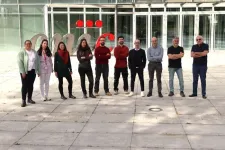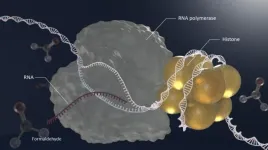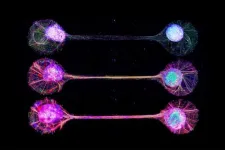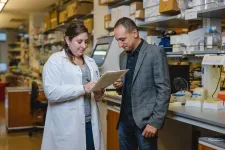New mechanism discovered for the life-threatening arrhythmias in Andersen-Tawil syndrome
The study, published in Circulation Research, establishes a direct link between these life-threatening arrhythmias and the C122Y mutation in the Kir2.1 potassium channel
2024-04-10
(Press-News.org)
A team at the Centro Nacional de Investigaciones Cardiovasculares (CNIC) has made a breakthrough discovery in the understanding of cardiac arrhythmias by unraveling the complexities of Andersen-Tawil syndrome (ATS), an extremely rare inherited cardiac disorder. Led by Dr. José Jalife, head of the CNIC Cardiac Arrhythmia Group, the study demonstrates that a specific genetic mutation (C122Y) in the Kir2.1 potassium channel alters the function not only of Kir2.1 but also of the main cardiac sodium channel NaV1.5, thus establishing a direct link with the life-threatening arrhythmias associated with ATS1.
The study, published in the journal Circulation Research, reveals that the C122Y mutation in Kir2.1 has a dual effect: it causes a reorganization of the Kir2.1 channel that destabilizes its binding to the phospholipid PIP2, a key lipid-signaling component of the cell membrane, and also disrupts the expression of the protein that forms the NaV1.5 channel, impairing its function. The interaction between these 2 channels is vital for a stable heart rate.
Cardiac arrhythmia affects an estimated 1 in 3 people at some point in their life, although ATS is a very rare disease that affects fewer than 1 in a million people. ATS is characterized by a triad of symptoms including periodic paralysis, cardiac arrhythmias, and distinctive facial features. ATS1 is caused by mutations in KCNJ2—the gene encoding Kir2.1—that are inherited in an autosomal dominant manner.
In the study, the researchers created a mouse model that replicates the major cardiac electrical irregularities observed in patients with ATS1. This model surprisingly revealed that the mutation not only affects Kir2.1, but also interferes with the stability and expression of the NaV1.5 channel in the heart, impairing its function.
Dr. Jalife underscored the importance of the interaction between these channels for cardiac health, explaining that any alteration that disturbs the function of one or both channels can trigger life-threatening arrhythmias.
Speaking about the new study, first author Dr. Francisco Cruz said, "The discovery that a mutation considered 'monogenic' disrupts not only the ion channel directly affected by the mutation, but also a complementary channel is important. Both channels are essential for cardiac excitability and electrical conduction, and the new discovery provides insight into the mechanisms underlying cardiac arrhythmias associated not only with ATS1, but also with more frequent cardiac diseases."
Dr. Cruz added that the results "support the hypothesis that molecular mechanisms vary according to the specific mutation, opening the door to personalized pharmacological treatments and clinical management for patients".
This advance, the researchers conclude, represents a milestone in the approach to cardiac arrhythmias, offering new understanding with potential clinical impact. Improving knowledge about the function of the Kir2.1 channel represents a key step towards innovative and safe approaches to preventing sudden death in several cardiac diseases, potentially benefiting millions of people worldwide.
The results of the new Circulation Research study support the hypothesis that the molecular mechanisms that increase susceptibility to arrhythmias and sudden cardiac death in ATS1 depend on the specific mutation, so that pharmacological treatment and clinical management should be tailored to each individual patient.
The study was funded by the National Heart, Lung, and Blood Institute of the NIH (USA); the la Caixa Foundation; the La Marató de TV3 Foundation; the Spanish cardiovascular research network (CIBERCV); the Horizon 2020 Programme of the European Union; and Program S2022/BMD7229. The imaging studies were performed at the TRIMA@CNIC node of the Distributed Biomedical Imaging Network (ICTS ReDIB).
About the CNIC
The CNIC is an affiliate center of the Carlos III Health Institute (ISCIII), an executive agency of the Spanish Ministry of Science, Innovation, and Universities. Directed by Dr. Valentín Fuster, the CNIC is dedicated to cardiovascular research and the translation of the knowledge gained into real benefits for patients. The CNIC has been recognized by the Spanish government as a Severo Ochoa center of excellence (award CEX2020-001041-S, funded by MICIN/AEI/10.13039/501100011033). The center is financed through a pioneering public-private partnership between the government (through the ISCIII) and the Pro-CNIC Foundation, which brings together 12 of the most important Spanish private companies.
END
ELSE PRESS RELEASES FROM THIS DATE:
2024-04-10
WINSTON-SALEM, N.C. – April 10, 2024 – Racial discrimination experienced during midlife is associated with Alzheimer’s disease pathology, according to a new study from researchers at Wake Forest University School of Medicine and the University of Georgia.
The findings appear online today in Alzheimer’s & Dementia: The Journal of the Alzheimer’s Association.
“We know that Black Americans are at an elevated risk of Alzheimer’s disease and other dementias compared to non-Hispanic ...
2024-04-10
Embargoed until 10:30 a.m. Wednesday, 10 April, 2024 Central European Summer Time (GMT +2)
10 April, 2024, Prague, Czech Republic—Speaking today at the Annual Meeting and Scientific Sessions of the International Society for Heart and Lung Transplantation (ISHLT) in Prague, Muhammad Mohiuddin, MBBS, said xenotransplantation, hailed as the future of organ transplantation, is poised to become a clinical reality within the next several years.
In January 2022, the University of Maryland School of Medicine (UMSOM) became the first institution in the world to implant a genetically modified pig heart ...
2024-04-10
Research Highlights:
Treating gum disease within three months after a heart procedure to correct an irregular heart rhythm, known as atrial fibrillation (AFib), may lower the chances of it reoccurring.
Inflamed gums may predict AFib recurrence after heart ablation, a procedure to fix the irregular heartbeat.
AFib patients should be examined for gum disease and encouraged to seek dental treatment, researchers said.
Embargoed until 4 a.m. CT/5 a.m. ET Wednesday, April 10, 2024
DALLAS, April 10, 2024 — Treating gum disease in the 3-months after a procedure to correct an irregular heartbeat known as atrial fibrillation ...
2024-04-10
Researchers at the National Institutes of Health applied artificial intelligence (AI) to a technique that produces high-resolution images of cells in the eye. They report that with AI, imaging is 100 times faster and improves image contrast 3.5-fold. The advance, they say, will provide researchers with a better tool to evaluate age-related macular degeneration (AMD) and other retinal diseases.
“Artificial intelligence helps overcome a key limitation of imaging cells in the retina, which is time,” said Johnny Tam, Ph.D., who leads the Clinical and Translational Imaging Section at NIH's National Eye Institute.
Tam ...
2024-04-10
A team of researchers at Nagoya University in Japan has discovered that aldehydes are metabolic byproducts associated with premature aging. Published in Nature Cell Biology, their findings reveal insights into premature aging diseases and potential strategies to combat aging in healthy individuals such as controlling exposure to aldehyde-inducing substances including alcohol, pollution, and smoke.
A person's health can be harmed by aldehydes. However, the group’s findings suggest these detrimental effects also include aging. The team who made this discovery included Yasuyoshi Oka, Yuka Nakazawa, Mayuko Shimada, and Tomoo Ogi of Nagoya University.
“DNA ...
2024-04-10
Chasing ever-higher qubit counts in near-term quantum computers constantly demands new feats of engineering.
Among the troublesome hurdles of this scaling-up race is refining how qubits are measured. Devices called parametric amplifiers are traditionally used to do these measurements. But as the name suggests, the device amplifies weak signals picked up from the qubits to conduct the readout, which causes unwanted noise and can lead to decoherence of the qubits if not protected by additional large components. More importantly, the bulky size of the amplification chain becomes technically challenging to work around as qubit counts increase ...
2024-04-10
Research has uncovered important new insights into the evolution of oxygen, carbon, and other vital elements over the entire history of Earth – and it could help assess which other planets can develop life, ranging from plants to animals and humans.
The study, published today in Nature Geoscience and led by a researcher at the University of Bristol, reveals for the first time how the build up of carbon-rich rocks has accelerated oxygen production and its release into the atmosphere. Until now the exact nature of how the atmosphere became oxygen-rich has long eluded scientists and generated conflicting explanations.
As carbon dioxide is steadily ...
2024-04-10
Tokyo, Japan – The idea of growing a functioning human brain-like tissues in a dish has always sounded pretty far-fetched, even to researchers in the field. Towards the future goal, a Japanese and French research team has developed a technique for connecting lab-grown brain-mimicking tissue in a way that resembles circuits in our brain.
It is challenging to study exact mechanisms of the brain development and functions. Animal studies are limited by differences between species in brain structure and function, and brain cells grown in the lab tend to lack the characteristic ...
2024-04-10
Researchers at Linköping University, Sweden, have developed a digital display screen where the LEDs themselves react to touch, light, fingerprints and the user’s pulse, among other things. Their results, published in Nature Electronics, could be the start of a whole new generation of displays for phones, computers and tablets.
“We’ve now shown that our design principle works. Our results show that there is great potential for a new generation of digital displays where new advanced ...
2024-04-10
PHILADELPHIA — (April 10, 2024) — The Wistar Institute’s associate professor Mohamed Abdel-Mohsen, Ph.D., along with his team and collaborators, has identified sugar abnormalities in the blood that may promote biological aging and inflammation in people living with HIV (PLWH). The findings, taken from a large data study comprising more than 1200 participants, are detailed in the new paper, “Immunoglobulin G N-glycan Markers of Accelerated Biological Aging During Chronic HIV Infection,” published in the journal Nature Communications.
Despite advances ...
LAST 30 PRESS RELEASES:
[Press-News.org] New mechanism discovered for the life-threatening arrhythmias in Andersen-Tawil syndrome
The study, published in Circulation Research, establishes a direct link between these life-threatening arrhythmias and the C122Y mutation in the Kir2.1 potassium channel









